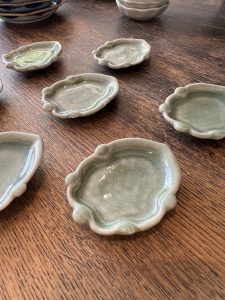三田青磁の小皿を手にしてみました。(愛知県名古屋市千種区姫池通 骨董買取 古美術風光舎)
2023.09.14
みなさまこんにちは、スタッフYでございます。

まあまあ長くこちらのスタッフをやっておりますが、あらためて骨董古美術の世界はほんとうに奥が深いと日々痛感しております。日々勉強や知識をいれようと頑張ってはおりますが、まだまだ自分の知らないものや知識に出会い「へーーっ、知らなかった。」と呟く毎日ですが、骨董や古美術品に引き込まれるってこういうことなのでしょうか、本当に面白さが尽きることなく好奇心をくすぐります。
今日、私の好奇心をくすぐってきましたのは
「三田青磁」
もちろんお目にかかるのは初めてです。恥ずかしながら知らなかったのですが、三田青磁は中国龍泉青磁、韓国高麗青磁と並び世界三大青磁の一つとも称されることがあります。
主に江戸時代後期(1799年)から生産が始まり、昭和の初期頃までは多く見かけましたが、江戸時代に三田市の「志手原」「三輪」「虫尾」の窯にて製造されていた三田焼のなかでも、青磁の原石が見つかったことで生産が始まったとされています。
内田忠兵衛によって発見され、その後、豪商の神田惣兵衛の支援によって三田青磁に数々の名品が生まれていき、国内のみならず、三田陶磁会社によって輸出なども積極的に行われたのですが、残念ながら昭和10年には生産が終わってしまったようですね。
ここで少し復習なのですが、青磁とは「表面を覆っているガラス」のことでして、釉薬(ゆうやく)にも種類がたくさんあるようでして、日本のみならず世界中でさまざまな焼き物文化が伝えられております。
今でこそ難しいものではないようですが、登場したばかりの頃は青磁は難易度も高く取り扱いにくいものだったようです。そのため原料を見て吟味する職人の目が必要だったとのこと。三田青磁は独特の透明感美しい発色もあり、中国の青磁と同じくらいレベルの高いものとして評価されるようになるのですがこれは当時の釉薬の質が高かったことが関係しているのでしょうか。
そんな青磁、長年質の良い青磁が中国から数多く日本に流入していましたが、しばらくすると輸入しなくなるようなります。それもそのはず輸入されなくなる頃にはすでに三田青磁として完成し、中国の青磁と見分けがつかないほどのレベルの高い青磁が作られるようになったのこともあるようですが、衣装的には中国のものとは違いはあり日本的な要要素を取り入れていたりしているようです。
この小皿も薄っすらと亀甲模様をほどこしているのですが、たしかにこの細かさは日本的な細かなクオリティだなと思えてきます。また、磁器は陶器よりも割れにくい性質を持っているからでしょうか、汚れがほとんど見当たりませんねので、割れさえしなければそのままの姿で維持できるのも三田青磁などの焼き物の素晴らしい点ともいえますね。
そんな青磁の歴史ですが、日本ではもともと平安時代に青磁の文化が認識されるようになりました。当時はもちろん国内ではなく中国から輸入したものが最も質の高いトップブランドが主流で、他にも韓国の高麗青磁なども知名度が高く知られてきます。
実は、青磁が最初に日本で焼かれたのは、17世紀初頭の肥前鍋島(現在の佐賀県)、やはり青磁石の採掘地でもありました。その後、別の青磁石が三田でも採掘されどうにか焼けないかと考え、当時殿様にも進言しても興味を持ってもらえず、神田惣兵衛を中心に動き、京都から優秀な陶工「欽古堂亀祐(きんこどうかめすけ)」を招きいれ「三輪明神窯」にて作り焼くことになったのが三田青磁の始まりのようです。
その三田青磁の仕上がりのレベルが高かったこともあり「中国のものと見間違うほど」と評判に。日本全国に広がると大阪や江戸にも青磁販売所ができ徐々に流通が拡大。三田青磁は「世界三大青磁」と言われるようになるのですが、中国や朝鮮の青磁とは違って、すさまじい速さでここまでのクオリティとブランドに育ったことは、他国の青磁とは大いに違うところですね。
そんな三田青磁のクオリティの特徴といいますと、一般的な焼き物といえば釉薬(ゆうやく)を1度かけて仕上げをしていくのですが、この三田青磁はその断面からも4回かけて作られていることがわかります。この独特の製法を使っていることで、奥深さも感じられ、自然な奥行きが出てくるよう。もともと釉薬は透明ではあるのですが、微量に鉄分が入っているものや職人の焼き方によってでしょうか、それぞれを塗り重ねるごとに違った色味になり、艶のある仕上がりになっています。どちらかというと淡いやわらかい色彩といった印象です。
また、釉薬の塗り方によってもそれぞでが変わってくるなど、とても繊細なもので、この小皿もそれぞれ手に取ると均一ではなく部分的に薄くなっていたりして違う厚みがグラデーションのように見えてきます。それがまたそれぞれ個性的な青磁の奥深さなどを見せてくれます。
一般的な青磁のあのガラスの釉薬のひやっとした印象をイメージとは一味違うこの三田青磁。手に取っているとわかるのですが、ひとつひとつ丁寧に作った職人が、それぞれの個性豊かな艶を生み出しているなと伝わるちょっと暖かい青磁でありました。
機会がございましたら、一度是非、手に取ってみてください。
それではごきげんよう。
Hello everyone, this is Staff Y.
I have been a staff member here for quite a long time, and I am keenly aware of how deep the world of antiques and antiques art really is. Although I try my best to study and gain knowledge every day, I still encounter things and knowledge that I do not know and mutter to myself, “Wow, I didn’t know that. I am still trying to learn and gain knowledge every day, but every day I come across things and knowledge that I do not know. I wonder if this is what it means to be drawn to antiques and antiquities, which really tickle my curiosity without end.
Today, my curiosity was piqued by
Sanda celadon porcelain.
Of course, this is the first time for me to see it. I am ashamed to admit that I did not know this, but Mita celadon is sometimes referred to as one of the world’s three major celadon wares, along with Chinese Longquan celadon and Korean Goryeo celadon.
Production mainly began in the late Edo period (1799) and was seen in large numbers until the early Showa period (1926-1989). It is said that production began when the original celadon stones were found among the Sanda ware produced in the Shidehara, Miwa, and Mushio kilns in Sanda City in the Edo period.
The discovery was made by Chubei Uchida, and later, with the support of the wealthy merchant Sohei Kanda, numerous masterpieces of Sanda celadon were produced, which were actively exported not only domestically but also by the Sanda Ceramic Company.
There are many types of glazes, and various pottery cultures have been handed down not only in Japan but also around the world.
Celadon glaze is not so difficult to make nowadays, but when it first appeared, celadon was very difficult to make and handle. Therefore, it required a craftsman’s eye to look at and examine the raw materials. Sanda celadon porcelain, with its unique transparency and beautiful coloring, came to be regarded as a high level of quality as Chinese celadon porcelain, which may be related to the high quality of glaze at that time.
For many years, many high-quality celadon wares flowed into Japan from China, but after a while, the importation of such wares stopped. However, there are some differences between Chinese celadon and Japanese celadon in terms of costume, and some Japanese elements have been incorporated into the Chinese celadon.
This small dish also has a thin tortoiseshell pattern, which is indeed a very fine Japanese quality. Porcelain is more resistant to cracking than ceramics, and there is almost no stain on the porcelain, so as long as the porcelain is not broken, it can be maintained in its original form, which is another wonderful point of Sanda celadon ware.
The history of celadon porcelain in Japan can be traced back to the Heian period (794-1192), when the culture of celadon porcelain was recognized. At that time, of course, the most high-quality top brands were imported from China, not domestically, and other well-known and well-known brands such as Koryo celadon from Korea.
In fact, celadon was first produced in Japan in the early 17th century in Hizen Nabeshima (present-day Saga Prefecture), which was also a place where celadonite was mined. Later, another type of celadon stone was mined in Sanda, and the local lord was not interested, so Kanda Sohei took the initiative and invited Kinkodo Kamesuke, an excellent potter from Kyoto, to make and bake celadon at the Miwa Myojin Kiln. This was the beginning of Sanda celadon porcelain.
The high level of finish of Sanda celadon porcelain was so high that it was mistaken for Chinese porcelain, and the reputation of Sanda celadon porcelain spread throughout Japan and spread to Osaka and Edo (now Tokyo). As Sanda celadon spread throughout Japan, celadon sales offices were established in Osaka and Edo (now Tokyo), and distribution gradually expanded. Mita celadon became known as one of the “world’s three major celadon porcelains.” Unlike celadon from China and Korea, Mita celadon has grown to such a high quality and brand in a tremendous speed, which is a great difference from celadon from other countries.
The quality of Mita celadon porcelain is characterized by the fact that it is generally glazed and finished once, but this Mita celadon porcelain is made four times, as can be seen from its cross section. The use of this unique process gives the piece a sense of depth and natural profundity. The glaze is transparent to begin with, but each coat gives a different color and glossy finish, perhaps due to the trace amount of iron in the glaze or the way the craftsman fired it. The coloring is rather pale and soft.
The glaze is also very delicate and varies depending on how it is applied, and when you pick up each of these small dishes, you can see a gradation of different thicknesses. This also shows the depth of each unique celadon.
This Mita celadon dish is different from the usual celadon dish with a glass glaze that gives a cold impression. As you can see when you hold it in your hand, it is a slightly warm celadon that conveys that the craftsmen who carefully made each piece have created their own unique glaze.
If you have a chance, why don’t you pick one up?
Good bye.
*******************
ご実家の整理やお片付けなどをされている方のご相談などが多くございます。
お片付けなどくれぐれもご無理のないようになさってくださいませ。
風光舎では古美術品や骨董品の他にも絵画や宝石、趣味のお品など様々なジャンルのものを買受しております。
お片付けをされていて、こういうものでもいいのかしらと迷われているものでも、どうぞお気軽にご相談下さいませ。
また風光舎は、出張買取も強化しております。ご近所はもちろん、愛知県内、岐阜県、三重県その他の県へも出張いたします。
まずは、お電話お待ちしております。
愛知県名古屋市千種区姫池通
骨董 買取【古美術 風光舎 名古屋店】
TEL052(734)8444
10:00-17:00 OPEN
#出張買取#骨董#古美術#骨董品#絵画#版画#茶道具#刀剣#彫刻

